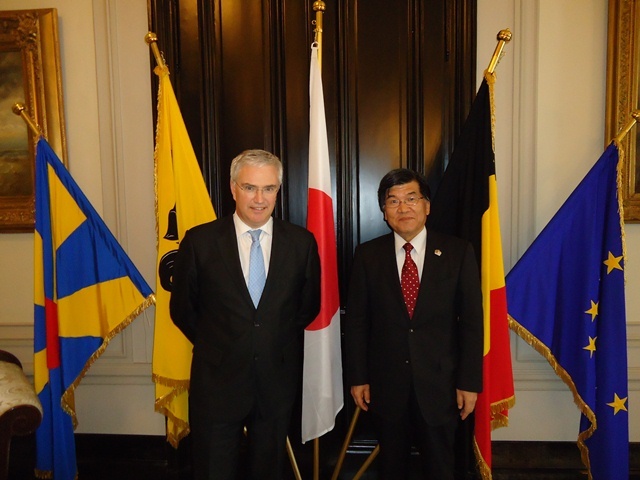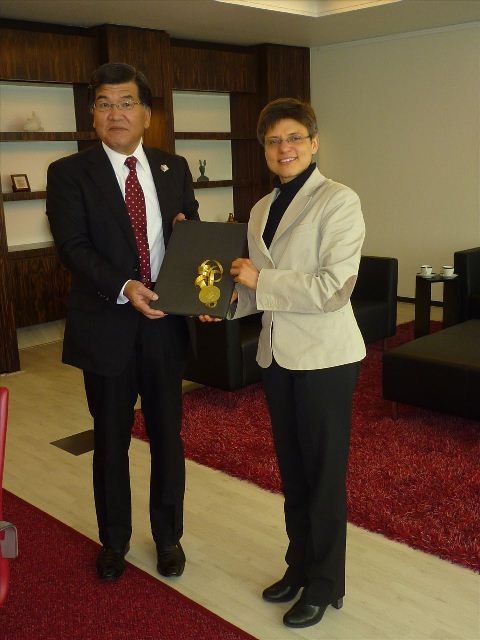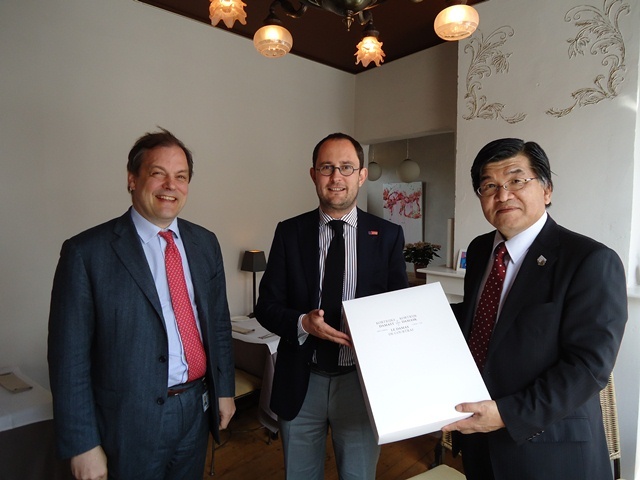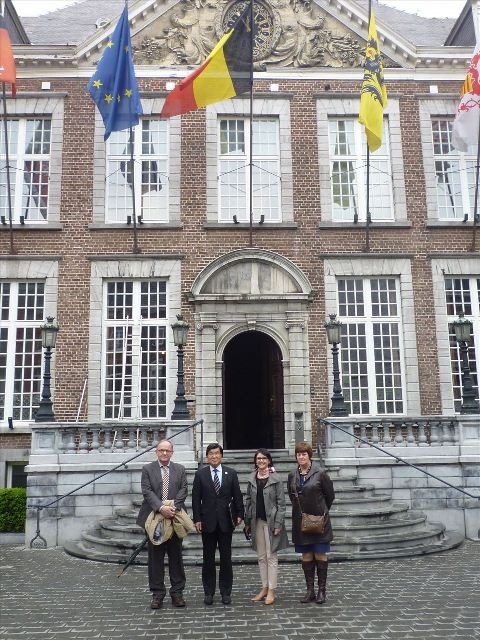Two Governors and Two Mayors (No.16)
The other day, when I was talking with a Belgian about what Belgians are proud of worldwide, I pointed out “beer and chocolate”, but I received a surprising answer. The person said that Belgians were proud of the production of billiard table cloth and playing cards worldwide. I looked it up at once to see whether it was true or false, and although it is not entirely true, it is pretty close. The thick green cloth on billiard tables is made of a specific fiber and needs to be of a quality that reflects perfectly the ball’s linearity, speed and rotation aimed for by the player. The Belgian said that only the company Simonis in Andrimont, located 120 km to the east of Brussels, is able to produce such fiber in the whole world. It seems that Simonis has been making only this one product since the end of the 17th century and the billiard cloth used for the billiard tables in international competitions are almost solely coming from this company. On the other hand, as for the playing cards, there is “Cartamundi” in Turnhout, located 84 km northeast of Brussels. Though this company itself was established as joint venture between three companies about 40 years ago, each company was originally a printing company with a history of over 200 years. Cartamundi has manufacturing sites in 8 countries and annual sales amount to 150 million euro, so no doubt that this company is a major player in this industry, but I was not able to confirm whether Cartamundi is No. 1 in the world. There is even a museum of playing cards in Turnhout; well, I admire that there is national pride in the most unexpected places.
< Two Governors >
 About 10 days ago I visited West Flanders, Belgium’s westernmost province, and met with Governor Carl DECALUWE at his office in Brugge. After having served as a member of the Flemish regional parliament for 17 years, he was appointed by the King to his current post of governor in February 2012. Only 52 years old, he is young and I think that he will work as governor for a long time. West Flanders is a prosperous province with the city of Brugge, the capital and one of the best sightseeing spots in Europe, there are the seaports of Zeebrugge and Oostende along the west coast and the seaside resort Knokke-Heist. However, promotion of industry seems to be a challenge in order to develop the local economy. According to the governor, the three strategic sectors are agro-food processing, chemistry (plastics) and clean energy, so he would like to focus on generating power by making use of offshore wind and wave power. He welcomes investments from Japanese companies and told me that they would like to realize a visit to Japan for the first time next spring. About 10 days ago I visited West Flanders, Belgium’s westernmost province, and met with Governor Carl DECALUWE at his office in Brugge. After having served as a member of the Flemish regional parliament for 17 years, he was appointed by the King to his current post of governor in February 2012. Only 52 years old, he is young and I think that he will work as governor for a long time. West Flanders is a prosperous province with the city of Brugge, the capital and one of the best sightseeing spots in Europe, there are the seaports of Zeebrugge and Oostende along the west coast and the seaside resort Knokke-Heist. However, promotion of industry seems to be a challenge in order to develop the local economy. According to the governor, the three strategic sectors are agro-food processing, chemistry (plastics) and clean energy, so he would like to focus on generating power by making use of offshore wind and wave power. He welcomes investments from Japanese companies and told me that they would like to realize a visit to Japan for the first time next spring.
 Two days ago, I visited Antwerp province again and paid a courtesy call to Governor Cathy Berx. She is a lecturer at the University of Antwerp and only 44 years old. Provincial governors in Belgium are relatively old because they are appointed by the king for life, so Governor Berx is exceptionally young. At present, she is President of the High Council at the University of Antwerp and she seems to hold many posts such as Chairwoman of the Institute of Tropical Medicine. As her husband is vice rector of the University of Antwerp, it is no exaggeration to say that husband and wife are shouldering the academic community of Antwerp. When I told her that Dr. Peter Piot (currently Director of the London School of Hygiene & Tropical Medicine), a Belgian who worked diligently on infectious disease issues in Africa, will be awarded this year’s Hideo Noguchi Africa Prize, she was exceedingly delighted. Furthermore, the governor is a big fan of Japanese literature and she cited Japanese authors, one after the other, from Yasunari Kawabata to Haruki Murakami. Every time I visit a different region in Belgium, I discovered Japan-fans in the most unexpected places. It really is amazing. Two days ago, I visited Antwerp province again and paid a courtesy call to Governor Cathy Berx. She is a lecturer at the University of Antwerp and only 44 years old. Provincial governors in Belgium are relatively old because they are appointed by the king for life, so Governor Berx is exceptionally young. At present, she is President of the High Council at the University of Antwerp and she seems to hold many posts such as Chairwoman of the Institute of Tropical Medicine. As her husband is vice rector of the University of Antwerp, it is no exaggeration to say that husband and wife are shouldering the academic community of Antwerp. When I told her that Dr. Peter Piot (currently Director of the London School of Hygiene & Tropical Medicine), a Belgian who worked diligently on infectious disease issues in Africa, will be awarded this year’s Hideo Noguchi Africa Prize, she was exceedingly delighted. Furthermore, the governor is a big fan of Japanese literature and she cited Japanese authors, one after the other, from Yasunari Kawabata to Haruki Murakami. Every time I visit a different region in Belgium, I discovered Japan-fans in the most unexpected places. It really is amazing.
< Two Mayors >
 The other day, I paid a visit to Kortrijk (75.000 inhabitants) located 90km to the west of Brussels and had lunch with mayor Vincent Van Quickenborne. He was elected to the post of mayor only last October and until shortly before he served as Deputy Prime Minister and Minister of Pensions of the federal government. And yet, it is a surprise to hear that he is only 39 years old. The mayor told me that the most important challenge for the city administration at the moment is to prevent depopulation and, in particular to stop the “brain drain” by providing attractive job opportunities for young people. In addition, being close to the border of France, cross-border crimes are increasing, so maintaining public security is also one of the tasks. He also told me that he has a strong interest in Japan. He has visited Japan many times and talked about the 2-week private trip he made with his wife 3 years ago. The CEO from a local company called “Van De Wiele” (production and sales of weaving machines; 2400 workers) joined us at the lunch table from the second half on and we talked about business relations with Japanese companies. I received an invitation from the CEO to visit his company, so I promised to visit it soon. The other day, I paid a visit to Kortrijk (75.000 inhabitants) located 90km to the west of Brussels and had lunch with mayor Vincent Van Quickenborne. He was elected to the post of mayor only last October and until shortly before he served as Deputy Prime Minister and Minister of Pensions of the federal government. And yet, it is a surprise to hear that he is only 39 years old. The mayor told me that the most important challenge for the city administration at the moment is to prevent depopulation and, in particular to stop the “brain drain” by providing attractive job opportunities for young people. In addition, being close to the border of France, cross-border crimes are increasing, so maintaining public security is also one of the tasks. He also told me that he has a strong interest in Japan. He has visited Japan many times and talked about the 2-week private trip he made with his wife 3 years ago. The CEO from a local company called “Van De Wiele” (production and sales of weaving machines; 2400 workers) joined us at the lunch table from the second half on and we talked about business relations with Japanese companies. I received an invitation from the CEO to visit his company, so I promised to visit it soon.
 Last week I paid a visit to Hasselt (80km to the northeast of Brussels; 73.000 inhabitants), the capital of the province of Limburg and met mayor Hilde Claes. Hasselt and Itami in Japan have been sister cities since 1985 and, in that connection, the mayor herself has just visited the city of Itami with a party of about 40 people only two weeks ago. It was her first visit to Japan and she talked about how she was deeply impressed by the cleanliness of the cities in Japan and how she experienced a big earthquake early in the morning of April 13 during her stay in Osaka. The center of Hasselt is different from other cities in Belgium in the sense that it is located within a ring road that draws a circle with a diameter of about 800m. The shopping town there in is like a labyrinth. Each road can be turned into a pedestrian’s heaven at any time and when the residents from the shopping district hold a barbecue party in front of the shops, the city provides even a subsidy. Friendship between local residents is promoted by this and intrusions by suspicious individuals have been reduced drastically by the fact that people know each other. It is indeed a unique endeavor. Last week I paid a visit to Hasselt (80km to the northeast of Brussels; 73.000 inhabitants), the capital of the province of Limburg and met mayor Hilde Claes. Hasselt and Itami in Japan have been sister cities since 1985 and, in that connection, the mayor herself has just visited the city of Itami with a party of about 40 people only two weeks ago. It was her first visit to Japan and she talked about how she was deeply impressed by the cleanliness of the cities in Japan and how she experienced a big earthquake early in the morning of April 13 during her stay in Osaka. The center of Hasselt is different from other cities in Belgium in the sense that it is located within a ring road that draws a circle with a diameter of about 800m. The shopping town there in is like a labyrinth. Each road can be turned into a pedestrian’s heaven at any time and when the residents from the shopping district hold a barbecue party in front of the shops, the city provides even a subsidy. Friendship between local residents is promoted by this and intrusions by suspicious individuals have been reduced drastically by the fact that people know each other. It is indeed a unique endeavor.
< History of the Queen Elisabeth International Music Competition >
At last, from May 6th on, the Queen Elisabeth Competition will be held. The laureates will be decided on the 1st of June, after a marathon session of nearly 1 month. Since the competition was held for the first time in 1951 under the name “Queen Elisabeth International Music Competition”, it will be now the 62nd year. During this time, the Japanese prize-winners amounted to 47 people (as far as I could check): 24 in the violin category, 18 in the piano category and 5 in the composition category. So far no-one won in the vocal category. Up until around 1960, most of the prize-winners were Westerners (especially performers from the Soviet Union). From Asia, there was only one Japanese winner in the piano competition in 1956 and one Japanese winner in the violin competition in 1959 (10th and 12th position respectively). When it comes to top-ranking winners, a Japanese musician won the third prize in the piano competition in 1971 for the first time, but from 1980 onwards the picture changed completely. In that year in particular the final of the violin competition was won by Ms. Yuzuko HORIGOME, but the 3rd and 4th prize as well were won by Japanese and from this moment on Japanese musicians are finishing each time in the top of this competition (2nd prize last year). The Japanese are so successful that we may even speak of a “Japanese hallmark”. In 1987 Akira WAKABAYASHI won the 2nd prize in the piano competition and also the 5th and 7th place were taken by Japanese musicians. We really have winners almost every time. However, from the violin competition in 1985 onwards, musicians from Korea, China and Taiwan started to win top rank prizes and became strong rivals for the Japanese in recent years. Interesting, on the other hand, is the fact that Mr. MOROI received a prize for Composition in 1953, and the fact that in 1977 the Japanese presence stood out from Asia by winning in the Composition Competition with both a work for symphony orchestra and a work for string quartet. The year before last as well a Japanese musician won the Grand Prix, so I am interested if the Japanese have a unique talent among Asians in the composition genre.
In fact, the Queen Elisabeth Competition was originally set up as the Eugene Ysaye Competition in 1937-1938 by Queen Elisabeth who loved music beyond all else, but was suspended after that. The Competition resumed in 1951 under the new name. In 1951, the year of the reopening, Mr Leonid KOGAN won the first prize in the violin category and in 1956 Mr. Vladimir ASHKENAZY won the first prize in the piano category, so for more than 60 years the competition continues to produce outstanding musicians. An anecdote goes that at the end of the Cold War between East and West, the Soviet Union did no longer send candidates to the competition because they were so angry about the fact that their musicians continued to seek asylum in the West. Being Japanese myself, it is a great honour that Japanese musicians are winning prizes in a music competition with such a long tradition. Well, who will turn out to be the winner this year?
< Ambassadors of Japan in Belgium >
The other day, a former Ambassador of Japan in Belgium, my third predecessor, came to Brussels and I invited his old Belgian friends to the Ambassador’s Residence for an informal get-together. It was a very pleasant evening talking about the good old days. At the beginning of my post in Belgium, I looked up the previous Ambassadors of Japan in Belgium. I found out that until now there have been 26 envoys since the time that Japan and Belgium started to exchange Ambassadors, of which 20 Japanese Ambassadors in the post-war period only. Seven years after diplomatic relations had been established at the end of the Edo period, in 1873, a Chargé d’Affaires for Japan was officially announced, but that doesn’t mean that he resided in Belgium as he held a concurrent post in The Netherlands. Although residency in Belgium started in 1898, the era of “Minister Extraordinary and Plenipotentiary” continued. It became “Ambassador Extraordinary and Plenipotentiary” after the official announcement of Ambassador Adachi Mineichiro in 1921, after the First World War. Before the Second World War, there were only 6 people appointed Ambassador, including Ambassador Adachi. Ambassador Adachi Mineichiro was a well-known figure in the world of diplomacy and international law for a long time; he served as judge and President of the Permanent Court of International Justice. Ambassador Adachi took up his post in Belgium in 1917, right in the midst of World War I, but his title at this time was “Minister Extraordinary and Plenipotentiary”. Then, as stated above, he was promoted to “Ambassador” 4 years later and he left Belgium in February 1928 after having served as Chief of Mission in Belgium for more than 10 years. The farewell reception, held in a hotel in Brussels, was attended by the Crown Prince, the Prime Minister and many leaders from various circles. It is indeed a brilliant history. The visitor from Japan mentioned at the beginning was the 23rd Ambassador, who achieved a lot during his term of office. The 26th Ambassador whom I am will do his best as well.
|